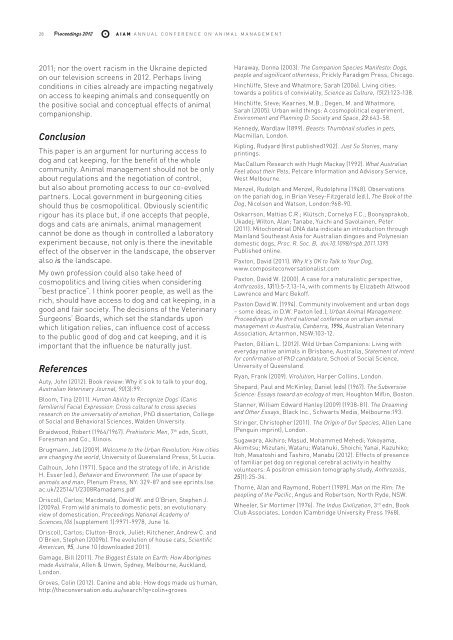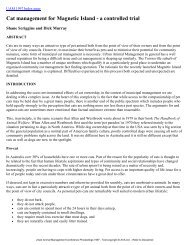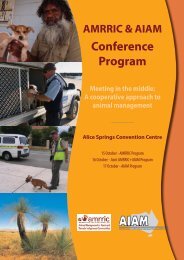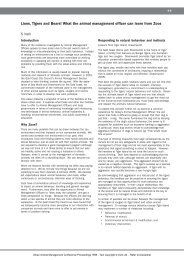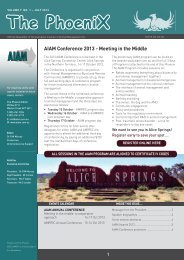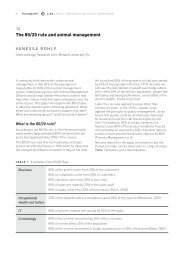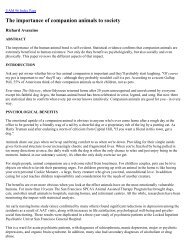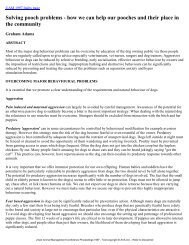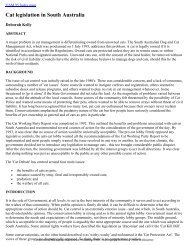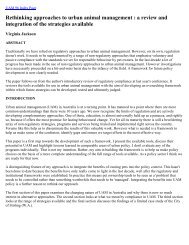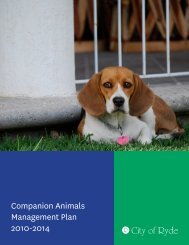Proceedings OF ThE - Australian Institute of Animal Management Inc
Proceedings OF ThE - Australian Institute of Animal Management Inc
Proceedings OF ThE - Australian Institute of Animal Management Inc
Create successful ePaper yourself
Turn your PDF publications into a flip-book with our unique Google optimized e-Paper software.
28 <strong>Proceedings</strong> 2012<br />
AIAM Annual Conference on <strong>Animal</strong> <strong>Management</strong><br />
2011; nor the overt racism in the Ukraine depicted<br />
on our television screens in 2012. Perhaps living<br />
conditions in cities already are impacting negatively<br />
on access to keeping animals and consequently on<br />
the positive social and conceptual effects <strong>of</strong> animal<br />
companionship.<br />
Conclusion<br />
This paper is an argument for nurturing access to<br />
dog and cat keeping, for the benefit <strong>of</strong> the whole<br />
community. <strong>Animal</strong> management should not be only<br />
about regulations and the negotiation <strong>of</strong> control,<br />
but also about promoting access to our co-evolved<br />
partners. Local government in burgeoning cities<br />
should thus be cosmopolitical. Obviously scientific<br />
rigour has its place but, if one accepts that people,<br />
dogs and cats are animals, animal management<br />
cannot be done as though in controlled a laboratory<br />
experiment because, not only is there the inevitable<br />
effect <strong>of</strong> the observer in the landscape, the observer<br />
also is the landscape.<br />
My own pr<strong>of</strong>ession could also take heed <strong>of</strong><br />
cosmopolitics and living cities when considering<br />
“best practice”. I think poorer people, as well as the<br />
rich, should have access to dog and cat keeping, in a<br />
good and fair society. The decisions <strong>of</strong> the Veterinary<br />
Surgeons’ Boards, which set the standards upon<br />
which litigation relies, can influence cost <strong>of</strong> access<br />
to the public good <strong>of</strong> dog and cat keeping, and it is<br />
important that the influence be naturally just.<br />
References<br />
Auty, John (2012). Book review: Why it’s ok to talk to your dog,<br />
<strong>Australian</strong> Veterinary Journal, 90(3):99.<br />
Bloom, Tina (2011). Human Ability to Recognize Dogs’ (Canis<br />
familiaris) Facial Expression: Cross cultural to cross species<br />
research on the universality <strong>of</strong> emotion, PhD dissertation, College<br />
<strong>of</strong> Social and Behavioral Sciences, Walden University.<br />
Braidwood, Robert (1964/1967). Prehistoric Men, 7 th edn, Scott,<br />
Foresman and Co., Illinois.<br />
Brugmann, Jeb (2009). Welcome to the Urban Revolution: How cities<br />
are changing the world, University <strong>of</strong> Queensland Press, St Lucia.<br />
Calhoun, John (1971). Space and the strategy <strong>of</strong> life, in Aristide<br />
H. Esser (ed.), Behavior and Environment: The use <strong>of</strong> space by<br />
animals and man, Plenum Press, NY: 329-87 and see eprints.lse.<br />
ac.uk/22514/1/2308Ramadams.pdf<br />
Driscoll, Carlos; Macdonald, David W. and O’Brien, Stephen J.<br />
(2009a). From wild animals to domestic pets, an evolutionary<br />
view <strong>of</strong> domestication, <strong>Proceedings</strong> National Academy <strong>of</strong><br />
Sciences,106 (supplement 1):9971-9978, June 16.<br />
Driscoll, Carlos; Clutton-Brock, Juliet; Kitchener, Andrew C. and<br />
O’Brien, Stephen (2009b). The evolution <strong>of</strong> house cats, Scientific<br />
American, 95, June 10 (downloaded 2011).<br />
Gamage, Bill (2011). The Biggest Estate on Earth: How Aborigines<br />
made Australia, Allen & Unwin, Sydney, Melbourne, Auckland,<br />
London.<br />
Groves, Colin (2012). Canine and able: How dogs made us human,<br />
http://theconversation.edu.au/search?q=colin+groves<br />
Haraway, Donna (2003). The Companion Species Manifesto: Dogs,<br />
people and significant otherness, Prickly Paradigm Press, Chicago.<br />
Hinchliffe, Steve and Whatmore, Sarah (2006). Living cities:<br />
towards a politics <strong>of</strong> conviviality, Science as Culture, 15(2):123-138.<br />
Hinchliffe, Steve; Kearnes, M.B.; Degen, M. and Whatmore,<br />
Sarah (2005). Urban wild things: A cosmopolitical experiment,<br />
Environment and Planning D: Society and Space, 23:643-58.<br />
Kennedy, Wardlaw (1899). Beasts: Thumbnail studies in pets,<br />
Macmillan, London.<br />
Kipling, Rudyard (first published1902). Just So Stories, many<br />
printings.<br />
MacCallum Research with Hugh Mackay (1992). What <strong>Australian</strong><br />
Feel about their Pets, Petcare Information and Advisory Service,<br />
West Melbourne.<br />
Menzel, Rudolph and Menzel, Rudolphina (1948). Observations<br />
on the pariah dog, in Brian Vesey-Fitzgerald (ed.), The Book <strong>of</strong> the<br />
Dog, Nicolson and Watson, London:968-90.<br />
Oskarrson, Mattias C.R.; Klütsch, Cornelya F.C.; Boonyaprakob,<br />
Ukadej; Wilton, Alan; Tanabe, Yuichi and Savolainen, Peter<br />
(2011). Mitochondrial DNA data indicate an introduction through<br />
Mainland Southeast Asia for <strong>Australian</strong> dingoes and Polynesian<br />
domestic dogs, Proc. R. Soc. B, doi:10.1098/rspb.2011.1395<br />
Published online.<br />
Paxton, David (2011). Why It’s OK to Talk to Your Dog,<br />
www.compositeconversationalist.com<br />
Paxton, David W. (2000). A case for a naturalistic perspective,<br />
Anthrozoös, 13(1):5-7,13-14, with comments by Elizabeth Attwood<br />
Lawrence and Marc Bek<strong>of</strong>f.<br />
Paxton David W. (1994). Community involvement and urban dogs<br />
– some ideas, in D.W. Paxton (ed.), Urban <strong>Animal</strong> <strong>Management</strong>:<br />
<strong>Proceedings</strong> <strong>of</strong> the third national conference on urban animal<br />
management in Australia, Canberra, 1994, <strong>Australian</strong> Veterinary<br />
Association, Artarmon, NSW:103-12.<br />
Paxton, Gillian L. (2012). Wild Urban Companions: Living with<br />
everyday native animals in Brisbane, Australia, Statement <strong>of</strong> intent<br />
for confirmation <strong>of</strong> PhD candidature, School <strong>of</strong> Social Science,<br />
University <strong>of</strong> Queensland.<br />
Ryan, Frank (2009). Virolution, Harper Collins, London.<br />
Shepard, Paul and McKinley, Daniel (eds) (1967). The Subversive<br />
Science: Essays toward an ecology <strong>of</strong> man, Houghton Miflin, Boston.<br />
Stanner, William Edward Hanley (2009) (1938-81). The Dreaming<br />
and Other Essays, Black <strong>Inc</strong>., Schwarts Media, Melbourne:193.<br />
Stringer, Christopher (2011). The Origin <strong>of</strong> Our Species, Allen Lane<br />
(Penguin imprint), London.<br />
Sugawara, Akihiro; Masud, Mohammed Mehedi; Yokoyama,<br />
Akimitsu; Mizutani, Wataru; Watanuki, Shoichi; Yanai, Kazuhiko;<br />
Itoh, Masatoshi and Tashiro, Manabu (2012). Effects <strong>of</strong> presence<br />
<strong>of</strong> familiar pet dog on regional cerebral activity in healthy<br />
volunteers: A positron emission tomography study, Anthrozoös,<br />
25(1):25-34.<br />
Thorne, Alan and Raymond, Robert (1989). Man on the Rim: The<br />
peopling <strong>of</strong> the Pacific, Angus and Robertson, North Ryde, NSW.<br />
Wheeler, Sir Mortimer (1976). The Indus Civilization, 3 rd edn, Book<br />
Club Associates, London (Cambridge University Press 1968).


